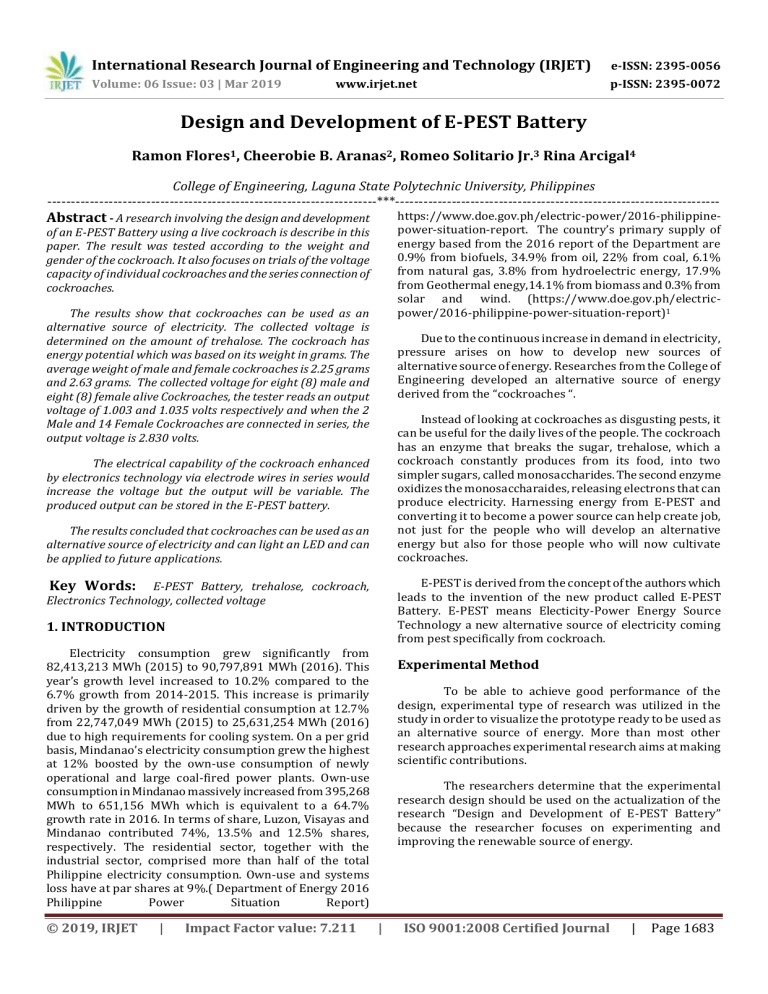IRJET- Design and Development of E-PEST Battery
advertisement

International Research Journal of Engineering and Technology (IRJET) e-ISSN: 2395-0056 Volume: 06 Issue: 03 | Mar 2019 p-ISSN: 2395-0072 www.irjet.net Design and Development of E-PEST Battery Ramon Flores1, Cheerobie B. Aranas2, Romeo Solitario Jr.3 Rina Arcigal4 College of Engineering, Laguna State Polytechnic University, Philippines ----------------------------------------------------------------------***--------------------------------------------------------------------- Abstract - A research involving the design and development https://www.doe.gov.ph/electric-power/2016-philippinepower-situation-report. The country’s primary supply of energy based from the 2016 report of the Department are 0.9% from biofuels, 34.9% from oil, 22% from coal, 6.1% from natural gas, 3.8% from hydroelectric energy, 17.9% from Geothermal enegy,14.1% from biomass and 0.3% from solar and wind. (https://www.doe.gov.ph/electricpower/2016-philippine-power-situation-report)1 of an E-PEST Battery using a live cockroach is describe in this paper. The result was tested according to the weight and gender of the cockroach. It also focuses on trials of the voltage capacity of individual cockroaches and the series connection of cockroaches. The results show that cockroaches can be used as an alternative source of electricity. The collected voltage is determined on the amount of trehalose. The cockroach has energy potential which was based on its weight in grams. The average weight of male and female cockroaches is 2.25 grams and 2.63 grams. The collected voltage for eight (8) male and eight (8) female alive Cockroaches, the tester reads an output voltage of 1.003 and 1.035 volts respectively and when the 2 Male and 14 Female Cockroaches are connected in series, the output voltage is 2.830 volts. Due to the continuous increase in demand in electricity, pressure arises on how to develop new sources of alternative source of energy. Researches from the College of Engineering developed an alternative source of energy derived from the “cockroaches “. Instead of looking at cockroaches as disgusting pests, it can be useful for the daily lives of the people. The cockroach has an enzyme that breaks the sugar, trehalose, which a cockroach constantly produces from its food, into two simpler sugars, called monosaccharides. The second enzyme oxidizes the monosaccharaides, releasing electrons that can produce electricity. Harnessing energy from E-PEST and converting it to become a power source can help create job, not just for the people who will develop an alternative energy but also for those people who will now cultivate cockroaches. The electrical capability of the cockroach enhanced by electronics technology via electrode wires in series would increase the voltage but the output will be variable. The produced output can be stored in the E-PEST battery. The results concluded that cockroaches can be used as an alternative source of electricity and can light an LED and can be applied to future applications. E-PEST is derived from the concept of the authors which leads to the invention of the new product called E-PEST Battery. E-PEST means Electicity-Power Energy Source Technology a new alternative source of electricity coming from pest specifically from cockroach. Key Words: E-PEST Battery, trehalose, cockroach, Electronics Technology, collected voltage 1. INTRODUCTION Electricity consumption grew significantly from 82,413,213 MWh (2015) to 90,797,891 MWh (2016). This year’s growth level increased to 10.2% compared to the 6.7% growth from 2014-2015. This increase is primarily driven by the growth of residential consumption at 12.7% from 22,747,049 MWh (2015) to 25,631,254 MWh (2016) due to high requirements for cooling system. On a per grid basis, Mindanao’s electricity consumption grew the highest at 12% boosted by the own-use consumption of newly operational and large coal-fired power plants. Own-use consumption in Mindanao massively increased from 395,268 MWh to 651,156 MWh which is equivalent to a 64.7% growth rate in 2016. In terms of share, Luzon, Visayas and Mindanao contributed 74%, 13.5% and 12.5% shares, respectively. The residential sector, together with the industrial sector, comprised more than half of the total Philippine electricity consumption. Own-use and systems loss have at par shares at 9%.( Department of Energy 2016 Philippine Power Situation Report) © 2019, IRJET | Impact Factor value: 7.211 Experimental Method To be able to achieve good performance of the design, experimental type of research was utilized in the study in order to visualize the prototype ready to be used as an alternative source of energy. More than most other research approaches experimental research aims at making scientific contributions. The researchers determine that the experimental research design should be used on the actualization of the research “Design and Development of E-PEST Battery” because the researcher focuses on experimenting and improving the renewable source of energy. | ISO 9001:2008 Certified Journal | Page 1683 International Research Journal of Engineering and Technology (IRJET) e-ISSN: 2395-0056 Volume: 06 Issue: 03 | Mar 2019 p-ISSN: 2395-0072 www.irjet.net Results and Discussion average output voltage of alive female cockroach is 0.265 volts. The design and development of the E-PEST Battery uses the cockroaches’ electrical capability to store energy. Series Testing for Alive Cockroaches Table 3. Alive Male Cockroach The prototype has four components such as cockroach source, capacitor component, and voltage booster. The main component is the cockroach source that is composed of 16 cockroaches connected in series using electrode wires, these cockroaches are put in place in the cockroach disk. The capacitor component will be connected in parallel with the cockroach source so that the DC voltage signal will be filtered. A 220 uF will be installed so that the electricity provided by the cockroach will be corrected. No. of Specimen 8 Total Voltage Table 3 shows the collected voltage of male cockroach, as a result, the voltage depends on the amount of trehalose contained in the male cockroach which is based on the weight in grams. Connecting them in series will increase the voltage but the output will be variable. The function of this project is to store the raw electricity from the live cockroach. The electricity from the cockroach is the primary source of the prototype. The electrodes should be inserted to the abdomen of the cockroach which store trehalose. The cockroach has electrolytic cell which produces an output voltage. Table 4. Alive Female Cockroach No. of Specimen 8 Total Voltage Table 1. Live Male cockroach output voltage Specimen No. 1 2 3 4 5 6 7 8 Average Weight of Cockroach (g) 2 2 2 2 3 2 2 3 2.25 Voltage (V) 0.233 0.274 0.213 0.270 0.282 0.170 0.253 0.253 0.244 Table 5: Alive Mix Male and Female Cockroach Table 5 shows the alive mix male and female cockroach and the voltage produced of mixed genders. Apparently it results to a diverse output. Having more female cockroach, the voltage output increases at 2.83 volts. Since female cockroaches shows more electric potential, greater number of female cockroach in the circuit, gives more voltage output. Table 2. Live Female cockroach output voltage Weight of Cockroach (g) 3 3 2 2 3 2 3 3 2.63 Voltage (V) 0.289 0.284 0.226 0.243 0.319 0.241 0.260 0.261 0.265 Table 6: Voltage Stored from the live cockroach Duration (minutes) 15 30 45 60 75 90 105 120 It can be gleaned from Table2, the output voltage and weight of female cockroach, that the highest output voltage recorded is specimen number 5 with 0.319 volts. The © 2019, IRJET | Impact Factor value: 7.211 Voltage (V) 1.035 1.035 Table 4 shows the collected voltage of female cockroach, as a result, the voltage depends on the amount of trehalose contained in the female cockroach which is based on the weight in grams. Table 1 shows the voltage produce by the cockroach and its corresponding weight in grams. The highest output voltage recorded is specimen number 5 with 0.282 volts. The average output voltage of live male cockroach is 0.244 volts. Specimen No. 1 2 3 4 5 6 7 8 Average Voltage (V) 1.003 1.003 | Voltage Stored (V) 0.993 1.003 2.075 2.125 2.105 2.005 2.015 2.002 ISO 9001:2008 Certified Journal | Page 1684 International Research Journal of Engineering and Technology (IRJET) e-ISSN: 2395-0056 Volume: 06 Issue: 03 | Mar 2019 p-ISSN: 2395-0072 www.irjet.net Table 6 shows the voltage stored from the live cockroach for every interval of 15 minutes, the voltage was checked to test the charging capability of the source. The highest charged output is achieved to be 60 minutes with 2.125 volts, followed by 2.105 volts for 75 and 105 minutes respectively. Next, was 2.075 volts for 45 minutes, 1.003 volts for 30 minutes and 0.993 volts for 15 minutes. 7) Pangaribuan, Yosephin (2010) “Fuel Cell” https://www.scribd.com/doc/38471318/fuel-cell September 30, 2010 8) Schubert (2010) “The Efficacy of Light Emitting Diode (LED) Lamps Used in Rural Communities of Nigeria“ A Research Project presented to the Department of Physics, University of Agriculture Yion Day Secondary School Gboko, Nigeria https://pdfs.semanticscholar.org/bed6/0c6ba79e4 e7042b2466e9f74eafcf3e6dfc4.pdf May 16, 2012Scott, J. S. et al (2010) “An Introduction to insect structure” Retrieved on February 2010 from http://www.biology.ualberta.ca/mitchell.hp/Struct ure/modules.pdf Conclusion After several months of working with the project and prototype, the researchers found out the following about The Design and Development of E-PEST Battery. 1. The heavier the weight of the cockroach the more electric potential energy it produces. 9) Siegert, Michael et al (2015) “Methanobacterium Dominates Biocathodic Archaeal Communities in Methanogenic Microbial Electrolysis Cells” https://www.engr.psu.edu/ce/enve/logan/publicat ions/2015-Siegert-etal-ACSSusChemEng.pdf June 5, 2015 a. The weight determines the amount of trehalose in the specimens syste b. The female cockroaches show more electric potential than male cockroaches. Due to its body structure which carries more trehalose in its system. 10) Singh (2009) “Basics of Light Emitting diodes, Characterizations and Applications” https://www.researchgate.net/publication/200071 029_Basics_of_Light_Emitting_diodes_Characterizati ons_and_Applications December 2009 2. The cockroaches can be connected in series via electrode wires. Having more cockroaches in the circuit will add up even more voltage. 3. The cockroach electric potential being charged overtime can reduced the voltage capacity. The decomposing body of the cockroach is one of the factors affecting the voltage capacity. 11) Soriano “Related Literature” https://www.scribd.com/document/96487896/Rel ated-Literature June 9, 2012 References 1) Department of Energy (2016) https://www.doe.gov.ph/electric-power/2016philippine-power-situation-report 2) Bullen, R.A. (2010) “Biofuel Cells and their development” August 11, 2010 3) Fayeez “Literature Review of Batttery-Powered and Solar-Powered Wireless Sensor Node” http://www.arpnjournals.com/jeas/research_pape rs/rp_2015yjeas_0215_1506.pdf February 2014 4) Hanis Zakiah Yusra Mohd Yusni (2014) “Biofuel from Banana Waste” August 28, 2014 5) Kirkham, M.B. (2014) “Principles of soil and plant water relations second edition” https://www.sciencedirect.com/book/9780124200 227/principles-of-soil-and-plant-waterrelations#book-description May 6, 2014 6) Neto, S. Aquino (2010) “An Overview of Enzymatic Biofuel Cells” April 20, 2010 © 2019, IRJET | Impact Factor value: 7.211 | ISO 9001:2008 Certified Journal | Page 1685



